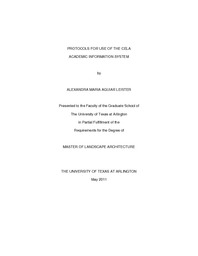| dc.description.abstract | The Academic Information System (AIS) is a digital database used by academic administrators in landscape architecture programs to store and analyze information about the operations of their academic units. It is an information access tool that allows administrators to compare information about their academic units with information from clusters of other academic units also involved in the education of landscape architects. The reasons for CELA to create the AIS were "to eliminate the making of critical decisions about landscape architecture education based on intuition-driven information reinforcing the idea that there are priorities for releasing the data" (Taylor, Ellis, Ozdil 2010). According to the Council of Educators in Landscape Architecture (CELA Academic Information System, 2010), the goal of the system's creators is to "establish the most complete database possible to help educators accomplish their missions." Since the AIS was first proposed by Archambeau and Taylor (2003), implemented in 2007, and incorporated into the CELA website in 2008, the data survey has been tested, edited and refined. Other stakeholders, such as students, faculty and alumni, do not have access to the data. However, the question remains regarding the kind of data that could or should be made available to the other stakeholders and the criteria involved in the process of releasing the data. To address these priorities, this research establishes protocols for accessing AIS data by administrators and other stakeholders involved in education such as faculty and students. The hypothesis of this research is that protocols are needed for the analysis and reporting of data from the AIS. The purpose is to determine how data from the AIS can be processed, for what purposes, and to whom the data should be released. In-depth interviews were used to understand stakeholder's perceptions and interest in the AIS. The interviews with landscape architecture stakeholders were analyzed to form the basis for the protocols to access the AIS. Findings show that besides administrators, faculty and students were perceived as users of the database. Moreover, the AIS has the potential to become a significant tool to aid the understanding, analysis and improvement of the quality of education in landscape architecture through dissemination of knowledge and research practices. | en_US |

